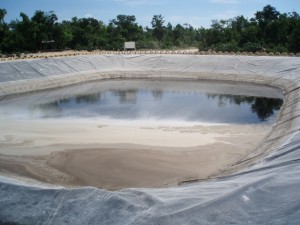What is leachate? In a lab, it is any liquid that extracts solids as it passes through matter. In a landfill, it is the water that enters the facility in a number of ways, passes through waste material on contact, contains a wide range of constituents, and must be addressed with a proper operations plan. Leachate treatment options and mitigation are one of the greatest costs for landfill operators today.

Rain falling on the landfill itself is the most common source of leachate, but water can also enter a landfill as runoff from locations nearby. Some water is also produced by waste decomposition itself, thus adding more leachate to the equation. No matter how it enters the facility, water in a landfill is exposed to contaminants including heavy metals, herbicides and pesticides. The treatment of leachate is managed by various options.
“Solid waste landfills must be designed to protect the environment from contaminants which may be present in the solid waste stream,” says the Environmental Protection Agency. “The landfill siting plan—which prevents the siting of landfills in environmentally-sensitive areas—as well as on-site environmental monitoring systems—which monitor for any sign of groundwater contamination and for landfill gas—provide additional safeguards.” Federal standards address:
- Location, ensuring that landfills are built away from faults, wetlands and flood plains.
- Composite and/or primary-secondary lining systems along the bottom and sides of the landfill to protect groundwater and the underlying soil.
- Leachate collection, detection and removal systems that sit on top or in between layers of the lining system.
- Operating practices that help reduce odors as well as control litter, insects, and rodents.
- Groundwater monitoring to determine whether waste materials have escaped from the landfill.
- Closure and post-closure care requirements that include prescriptive closing of landfills and caring for the closed facilities.
Leachate and Treatment Options
In its recent special report on landfills, Waste360 said, “Such a complex solution—fluid containing compounds both inorganic and organic, from arsenic to xylene—prompts the need for management solutions that protect the community, the environment and the budgets that finance waste disposal operations.” It outlined seven ways to address leachate, including:
- Diversion – keeping harmful materials from ever entering the landfill.
- Pretreatment – surface ponds, biological reactors, physical/chemical plants, constructed wetlands and reverse osmosis.
- Land application – grasses and trees can absorb certain contaminants.
- Recirculation – sent back into the landfill, the water helps speed the breakdown of organic materials.
- Evaporation – leachate is sprayed onto the working face, the surface of a storage pond or mechanically evaporated on-site.
- Wetlands – natural processes speed treatment in lined, constructed wetlands.
- Hauling – a costly last resort.
The most effective way to reduce leachate may be to keep water out of the facility in the first place with a close-as-you-go approach. An impermeable closure system using AGRU America’s geomembrane products that include an Integrated Drainage System (IDS) meet all requirements for closure and have been used in various closure applications across the world. The IDS system produces unmatched shear strengths (if needed) and includes a drainage material within the geomembrane. This unique system offers economical benefits when compared to geocomposite drainage products and provides superior performance. The geomembrane layer can be installed in advance of the full closure system, thus providing the precipitation avoidance and increased landfill gas capture benefits of a full closure system.
Many landfills utilize or evaluate the use of “temporary capping geomembranes” for precipitation avoidance and landfill gas odor mitigation. The temporary membranes are more economical than a traditional 40 or 60 mil product and are used to temporarily prevent precipitation from entering a specific area of the landfill. AGRU offers smooth and MicroSpike geomembranes that are used in temporary applications.
Also available is the AGRU ClosureTurf system. The system is comprised of a covered structured geomembrane and an engineered synthetic turf, providing all of the benefits of a soil cover without the issues that soil can cause. It has a proven track record of significantly outperforming traditional vegetative closure methods with regard to installation, maintenance and environmental compliance.
